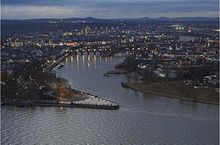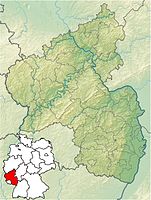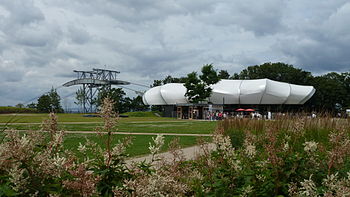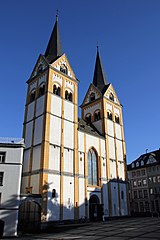 | ||
| Koblenz | ||
| federal state | Rhineland-Palatinate | |
|---|---|---|
| Residents | 114.024 (2019,2019) | |
| height | 73 m | |
| no tourist info on Wikidata: | ||
| location | ||
| ||
Koblenz is a city in the north of Rhineland-Palatinate at the confluence of the Moselle in the Rhine. She lies in Middle Rhine Valley and at the end of the Moselle valley. Koblenz is the most important city in the Middle Rhine Valley. The name Koblenz is derived from Confluentes ab, Latin for “confluence”. Koblenz marks the border between the Upper and Lower Middle Rhine. The mouth of the river is also just a few kilometers south Lahn. Koblenz is therefore exactly in the middle between the four parts of the Rhenish Slate Mountains: Eifel (on the left bank of the Rhine, north of the Moselle), Westerwald (on the right bank of the Rhine, north of the Lahn), Hunsrück (left bank of the Rhine, south of the Moselle) and Taunus (on the right bank of the Rhine, south of the Lahn).
Districts
The Rhine valley south of the mouth of the Moselle is comparatively narrow with steep slopes towards the Hunsrück and Westerwald; only the compact city center and the old town are flat. To the north of the mouth of the Moselle, the Rhine Valley widens to the left of the Rhine, and the slopes of the Westerwald to the right of the Rhine extend to the river. For urban development, this meant that since industrialization, the city had expanded mainly on the left bank of the Rhine towards the northwest (Lützel district).
The historical Old town as well as the adjoining one to the south southern suburb and, located on a former Rhine island, Oberwerth lie up the Rhine in the Rhine Valley, Rauental, Gold mine and Moselle white up the Moselle in the valley in the gusset between the rivers. In between there is a foothill of the Hunsrück with the, once a fortress, the Karthaus district.
Lying on the right bank of the Rhine Ehrenbreitstein and Pfaffendorf in the narrow strip between the Rhine and the slope, which they still have to share with the railroad and the federal road, to the east on the height Asterstein and Pfaffendorfer Höhe.
To the left of the Rhine and north of the Moselle lie in the plain of the Neuwied Basin Lützel, Metternich, Neuendorf and other, heavily commercial districts.
The old town and Ehrenbreitstein are of particular interest to visitors. Both are compact and within walking distance, but in Ehrenbreitstein there are inclines.
background
Koblenz is the most important city in the Middle Rhine Valley. It is right at the mouth of the Moselle into the Rhine, which is called the German Corner. The name Koblenz is derived from Confluentes ab, Latin for “confluence”. Koblenz marks the border between the Upper and Lower Middle Rhine. The mouth of the river is also just a few kilometers south Lahn. Koblenz is therefore exactly in the middle between the four parts of the Rhenish Slate Mountains: Eifel (on the left bank of the Rhine, north of the Moselle), Westerwald (on the right bank of the Rhine, north of the Lahn), Hunsrück (left bank of the Rhine, south of the Moselle) and Taunus (on the right bank of the Rhine, south of the Lahn).
The strategically important location made Koblenz a city strongly dominated by fortifications since ancient times. The Ehrenbreitstein fortress on the right bank of the Rhine still dominates the panorama today; the main station is dominated by the Fort Konstantin. These are only a selection of a dozen fortresses in the urban area that date from different centuries.

getting there
By plane
The closest airports are Cologne-Bonn Airport![]() (IATA: CGN), Dusseldorf Airport
(IATA: CGN), Dusseldorf Airport![]() (IATA: DUS), airport Frankfurt
(IATA: DUS), airport Frankfurt![]() (IATA: FRA) and Frankfurt Hahn Airport
(IATA: FRA) and Frankfurt Hahn Airport![]() (IATA: HHN). The first three can be changed by train, the latter can be reached by bus. The journey time is just over an hour each.
(IATA: HHN). The first three can be changed by train, the latter can be reached by bus. The journey time is just over an hour each.
By train
The 1 Koblenz Central Station is located on the southwest edge of the city center. ICE, IC, EN, CNL, RE and RB trains stop there. It takes about 1 hour each from Mainz and Cologne. Long-distance trains connect Koblenz with, among others, Hamburg, the Ruhr area, Cologne, Mainz, Frankfurt a.M., Stuttgart and Trier. The following local transport lines stop at Koblenz main station:
Regional Express
- RE 1RE 11 Mannheim Hbf / Luxembourg Gare - Trier Hbf - Koblenz main station
- RE 2 Frankfurt (M) Hbf - Frankfurt (M) Airport - Mainz Hbf - Koblenz main station
- RE 5Koblenz main station - Koblenz city center - Bonn Hbf - Cologne Hbf - Düsseldorf Hbf - Düsseldorf Airport - Wesel
- RE 8Koblenz main station - Koblenz Ehrenbreitstein - Neuwied - Cologne Trade Fair / Deutz - Cologne Central Station - Mönchengladbach
- RE 17Koblenz main station - Oberwesel - Bad Kreuznach - Kaiserslautern Hbf
- RE 25 Giessen - Limburg (Lahn) - Bad Ems - Koblenz main station
Regional train
- RB 10 Frankfurt (M) Hbf - Wiesbaden Hbf - St.Goarshausen - Koblenz main station - Koblenz city center - Neuwied
- RB 23 Limburg (Lahn) - Niederlahnstein - Koblenz main station - Koblenz city center - Andernach - Mayen East
- RB 26 Mainz Hbf - Bingen Hbf - Koblenz main station - Koblenz city center - Koblenz-Lützel - Bonn Hbf - Köln Hbf - Köln Messe / Deutz
- RB 27Koblenz main station - Koblenz city center - Koblenz-Lützel - Neuwied - Cologne Trade Fair / Deutz - Cologne Central Station - Mönchengladbach
- RB 81Koblenz main station - Koblenz-Moselle White - Koblenz-Güls - Cochem (Mosel) - Trier main station
At the centrally located 2 Koblenz city center stopRegional train and regional express trains stop right at the Löhr shopping center. There is also the in the city of Koblenz 3 Koblenz-Lützel train station on the left stretch of the Rhine north of the Moselle. The 4 Koblenz Ehrenbreitstein train station is on the right bank of the Rhine, the RE8 from / to Mönchengladbach stops here. On the Moselle route from / to Trier are the 5 Koblenz-Moselweiß railway station and the 6 Koblenz Güls train station.

In the street
Motorways: Koblenz is through the ![]() from Trier to Dreieck Dernbach (20km northeast of Koblenz), which is connected to the Dernbacher Dreieck
from Trier to Dreieck Dernbach (20km northeast of Koblenz), which is connected to the Dernbacher Dreieck ![]() is connected from Frankfurt to Cologne. The most important exit is the motorway-like exit 10 Koblenz-North, from which you can use the
is connected from Frankfurt to Cologne. The most important exit is the motorway-like exit 10 Koblenz-North, from which you can use the ![]() after approx. 5 kilometers you will reach Koblenz from the north. To reach the districts on the right bank of the Rhine, exit 11 Bendorf / Neuwied be appropriate. The
after approx. 5 kilometers you will reach Koblenz from the north. To reach the districts on the right bank of the Rhine, exit 11 Bendorf / Neuwied be appropriate. The ![]() From Ludwigshafen to Cologne, Koblenz passes west with exits 40 Koblenz / Waldesch with connection to the
From Ludwigshafen to Cologne, Koblenz passes west with exits 40 Koblenz / Waldesch with connection to the ![]() 15 km south of Koblenz and exits 39 Koblenz / Dieblich and 38 Koblenz-Metternich, each about 10 km to the west.
15 km south of Koblenz and exits 39 Koblenz / Dieblich and 38 Koblenz-Metternich, each about 10 km to the west.
Federal highways: The ![]() (left bank of the Rhine) and
(left bank of the Rhine) and ![]() (on the right bank of the Rhine) run along the Rhine and cross Koblenz in a north-south direction. The Hunsrückhöhenstrasse flows south of Koblenz (
(on the right bank of the Rhine) run along the Rhine and cross Koblenz in a north-south direction. The Hunsrückhöhenstrasse flows south of Koblenz (![]() ) on the south bridge and sits down as
) on the south bridge and sits down as ![]() to Montabaur. The runs along the Moselle
to Montabaur. The runs along the Moselle ![]() from Treis-Karden on the left bank of the Moselle in Koblenz and the
from Treis-Karden on the left bank of the Moselle in Koblenz and the ![]() on the right bank of the Moselle. The
on the right bank of the Moselle. The ![]() through the Lahn valley flows south of Koblenz into the
through the Lahn valley flows south of Koblenz into the ![]() .
.
Due to its topographical location, Koblenz is not really car-friendly, despite some attempts towards a car-friendly city from the 1970s. In the narrow valleys and along the rivers, traffic is concentrated in a few aisles that are prone to congestion. There is often a lack of space for parking spaces, which are accordingly scarce. The high number of professional commuters does the rest. Within Koblenz you should leave your car behind and use public transport or on foot.
By bus
- There are regional bus connections, e.g. to Mayen, Simmering in Hunsrück, Montabaur, Hachenburg and Altenkirchen.
- Some of the EVM city bus routes operate Park-and-ride facilities on the outskirts, from which the city center can be reached by bus.
- There are also services at the main train station bus station Long-distance bus lines the Flixmobility GmbH (Flixbus) and the Eurolines (German Touring).
By boat
- Passenger shipping on Rhine and Moselle (on the Rhine e.g. the Cologne-Düsseldorfer).
- Passenger shipping Gebr. Kolb, Cochem - Treis - Koblenz line
By bicycle
Koblenz can be easily reached via the long-distance cycle paths along the rivers: Rhine cycle route, Moselle cycle path and Lahn valley cycle path.
mobility


Koblenz owns a well developed city bus systemthat connects the city with the districts. There are night buses on weekends and public holidays. The network is run by the evm Verkehrs GmbH operated. further information: Line network and transfer stops in Koblenz
- Regional public transport - Koblenz is a member of Rhein-Mosel Transport Association (VRM).

- Old Town Express - The Express (technically a Pathway) runs from the Deutsches Eck through the old town of Koblenz (travel time 30 - 35 minutes). The train runs every hour between 10 a.m. and 5 p.m. between the beginning of April and the end of October. Fares 2019: adults: 6 €, children (up to 10 years): 2 €, family ticket: 14 €.
- Rhine cable car - The spectacular 2-cable gondola to Ehrenbreitstein Castle was built for the 2011 Federal Horticultural Show and will run until 2026 drive. The 950 m long cable car is the most powerful cable car in the world with 7600 passengers per hour. The Ehrenbreitstein Fortress on the right bank of the Rhine can be reached directly from the Rhine promenade on the left bank of the Rhine by cable car. There have been concerns that it is endangering the UNESCO World Heritage Site status in the Rhine Valley. Originally, it was therefore supposed to be dismantled in 2014.
The cable car operates all day in the summer months (April to October, and on weekends and public holidays in the remaining months. Operating times are usually 9:30 a.m. to 6:30 p.m.). Details on the Website of the Koblenz cable car. Prices (as of 2018): Ascent and descent: adults € 11 / children € 5, single trip: € 8 / € 4.50, bicycle transport: € 2.50 (H / R). The cable car is barrier-free (accessible for prams and wheelchairs).
- Rhine ferry Koblenz - Ehrenbreitstein The Rhine ferry between Ehrenbreitstein and Koblenz generally operates at the following times as required Click here
Tourist Attractions

Old town
- Four towers - Bay windows of the baroque corner houses at the intersection of Altengraben / Am Plan and Marktstrasse / Löhrstrasse.
Churches

In the old City:
- 1 Church of Our Lady
- 2 Florin's Church
- 3 Jesuit Church
At the Deutsches Eck:
- 4 Basilica of St. Castor, Kastorhof. oldest church in Koblenz.
Castles, chateaux and palaces


- 5 Ehrenbreitstein Fortress. The fortress is located on a rock above the right bank of the Rhine and was renovated in 2010. A cable car connects the Deutsches Eck with the plateau.
- 6 Electoral City Castle Koblenz (Old Castle). The castle from 1185 is located on the banks of the Moselle. Today it houses parts of the city library and the city archive. The stairwell can be viewed during the opening hours of the City Archives: Mondays, Tuesdays, Thursdays and Fridays from 2 p.m. to 5 p.m.
- 7 Electoral palace. The representative palace building from the second half of the 18th century for the Archbishop of Trier and Elector Clemens Wenzeslaus of Saxony has been completely rebuilt after its destruction in the Second World War and houses some federal authorities. Viewing is only possible from the outside.
- 8 Stolzenfels Castle. approx. 5 km south of Koblenz am Rhein · Bus line “650 Boppard” to the stop “Stolzenfels-Schlossweg”.
Buildings
- 9 Balduin Bridge - It is the oldest surviving Koblenz bridge and dates from the 14th century. However, parts of the bridge were demolished in the 1960s to make way for shipping by channeling the Moselle.
Monuments and fountains
- 10 Kaiser Wilhelm Monument at the Deutsches Eck. Monumental equestrian statue for Kaiser Wilhelm I. The viewing platform on the base, which is accessible free of charge, can be climbed via a narrow spiral staircase. From up here you have an attractive view over the Deutsches Eck and over the Rhine to the Ehrenbreitstein Fortress.Open: April 1 - October 31: 8 a.m. - 8 p.m.Price: free.
- The Schängelbrunnen at the old town hall was dedicated to the "mascot" of the city of Koblenz. The word Schängel comes from the French "Jean" and was originally intended as a swear word, but is now used as an affectionate term for the people of Koblenz.
- Empress Augusta enclosures in the southern part of the Rhine facilities.
Museums
- 11 Rhine Museum Koblenz, Charlottenstrasse 53 a, 56077 Koblenz-Ehrenbreitstein (Ehrenbreitstein train station, Rhine ferry, bus lines 9 and 10 - “Charlottenstraße” stop. Line 8 - Bahnhof Ehrenbreitstein, approx. 50 m from the museum.). Tel.: 49 (0)261 70 34 50. Cultural history museum, life on the Rhine is shown on 1,300 square meters. Topics include Rhine shipping, Rhine romance, river biology, Rhineland regions, hydraulic engineering and floods.Open: Tue - Sun 10 a.m. - 5 p.m.Price: Admission: € 5, reduced (students, schoolchildren): € 3, family ticket: € 11.
- 12 Romanticum Koblenz. modern, interactive adventure museum on the topic of Rhine romanticism and the Middle Rhine. The exhibition takes the visitor as a passenger on a steamship on a journey through time through the myth of the "Middle Rhine". The museum is located in the new architectural building of the "Forum Confluentes" cultural center.
- 13 Middle Rhine Museum Koblenz. Tel.: 49 (0)261-129 2502, Email: [email protected]. im Forum Mittelrhein, Zentralplatz 1, 56068 Koblenz - painting collection.Open: Tue - Sun 10 a.m. - 6 p.m.
- 14 German Railway Museum Koblenz, Schönbornsluster Strasse 14, 56070 Koblenz (How to get there: Koblenz-Lützel train station, 15 minutes' walk, bus 354 Koblenz Hbf - Koblenz-Lützel stop at DB Museum). Tel.: 49 (0)261 396 13 38, 49 (0)261 396 13 39, Email: [email protected]. In a former locomotive hall of the BW Koblenz-Lützel historic electric and steam locomotives, passenger coaches and saloon coaches can be viewed. In addition to numerous original vehicles, the museum shows various exhibitions on the development of passenger coaches and saloon cars, drive technology in electric locomotives and the development of train protection. Model railroad fans will also get their money's worth here: there are railroad models in three different sizes: from the classic H0 train to the garden train to the 5-inch ride-on train.Open: Sa: 10 am-4pm; Jul Aug .: Tue Sa 10: 00-16: 00.Price: Admission: € 3, children (6-17 years): € 1.50, families (2-4): € 6.
- 16 State Museum Koblenz. at Ehrenbreitstein Fortress - technical-historical collection and exhibition with archaeological finds from the long cultural history of the Middle Rhine region.
- 17 Ludwig Museum in the Deutschherrenhaus. Tel.: 49 (0)261 304 04 16, Email: [email protected]. Museum of contemporary art from the post-war period to the present with a focus on French art.Open: Tuesday to Saturday from 10:30 a.m. to 5:00 p.m., Sunday and public holidays from 11 a.m. to 6:00 p.m.Price: Admission: € 5, reduced: € 3, children up to 12 years free.
- 18 Museum Schloss Stolzenfels (Bus line 650 to Boppard to "Stolzenfels-Schlossweg"). In the 19th century from the ruins of a 13th century castle, with an associated park and gardens. It towers across the Rhine Oberlahnstein between Rehns and Koblenz.Open: Open: Tuesday to Sunday from 9 a.m. to 5 p.m., except December.Price: Admission: € 4, children and young people: € 2.50, families: € 8.
- 19 Mother Beethoven House, Wambachstrasse 204, 56077 Koblenz (Ehrenbreitstein). Tel.: 49 (0)261 9730669. Birthplace of Maria Magdalena van Beethoven, née Kevenich, mother of Ludwig van Beethoven, with exhibitions on the history of the family and Ehrenbreitstein.Open: Sun and public holidays 2:00 p.m. to 6:00 p.m.Price: € 3, reduced € 2.
- Rhenish Carnival Museum
- Defense technology study collection Koblenz
- Note: The Middle Rhine Postal Museum has been closed. The exhibits were "bequeathed" to the Post Museum in Frankfurt am Main.
Streets and squares
- Deutsches Eck: The confluence of the Rhine and Moselle rivers with the Kaiser Wilhelm monument and a beautiful view of the Ehrenbreitstein fortress opposite.
- The "Konrad-Adenauer-Ufer" is the northern part of the Rhine systems. The flower courtyard at the Deutsches Eck. The 2011 Federal Garden Show took place here and on the Ehrenbreitstein Fortress.

- The plan: Central square in the old town with various gastronomic offers. Another popular place in the old town is the Jesuitenplatz at the town hall.
- Gorresplatz - with the fountain and the approx. 10 m high history column in the middle of the square.
- Coin place - Only the former home of the mint master, which was built in 1761/63, is preserved today
Parks

The left bank of the Rhine is developed as a green area from the Deutsches Eck to the Rheinlache in Oberwerth and is also called the Rheingarten. Between the Deutsches Eck and the Pfaffendorfer Bridge, the bank of the Rhine is called "Konrad-Adenauer-Ufer" and south of the bridge Empress Augusta complex.
activities
hike left bank of the Rhine:
- The Rheinburgenweg grazes Koblenz only in the south, it leads around Koblenz-Karthauser to the Moselle, from the Moselle bridge in Koblenz-Güls it then goes to Winningen and only comes behind And afterwards back to the Rhine.
- The Rheinhöhenweg and the European long-distance hiking trail 8 lead from the south bridge directly on the Rhine to the Deutsches Eck, from there on the Moselle and over the Moselle bridge to Koblenz-Güls and then directly to And afterwards.
- On the Moselsteig. The end point is at the Deutsches Eck.
hike on the right bank of the Rhine:
- On the Rheinsteig
Regular events
- Old town festival Koblenz. Price: free entry.
- Juggler Festival Koblenz, in the old City. Juggler and cabaret festival.Price: tickets.
- Rhine in Flames, between Spay / Braubach and Koblenz. numerous illuminated ships gather in front of Spay, from about 9 p.m. the ships start in the direction of Koblenz; Towns and buildings shine with special lighting; Buildings are lit with red Bengal fires; imposing fireworks on the route as long as the column of ships is in their vicinity; The fireworks can be observed from land at suitable locations; if the tour is well planned, it might even be possible to "ride along" by bike (approx. 18 km).Price: boat trip approx. € 70.
shop
- Löhr-Center at Koblenz-Stadtmitte train station
- Löhr Street
- Forum Mittelrhein on the central square
kitchen
nightlife
The old town is quite lively thanks to the many pubs, bars and restaurants. Since the protection of non-smokers in Rhineland-Palatinate is less pronounced than in other federal states, there are even some smoking bars. There are also trendy and music bars in the old town. The music, cabaret and theater club is known nationwide Café Hahn in the Güls district.
accommodation
Cheap
- 1 Youth hostel Koblenz. In the Ehrenbreitstein Fortress, due to its location high above the Rhine opposite the mouth of the Moselle, it is one of the most popular youth hostels in Germany. Renovated in 2010, it has 157 beds in rooms for 1, 2, 4 and multiple beds, all with shower / toilet.Price: overnight stays from € 28.
- 2 NAUS Camping Park Rhein-Mosel / Koblenz, Schartwiesenweg 6 56070 Koblenz. Tel.: (0)261 82719, Email: [email protected]. is conveniently located at the mouth of the Moselle, opposite the Deutsches Eck.
medium
Upscale
- Holiday, sport and active hotel drawbridge is about 15 km from Koblenz in Grenzau. Can be reached quickly and easily via the motorway.
Learn
security
The Koblenz districts of Neuendorf and Lützel, a not very engaging residential area directly north of the Deutsches Eck on the opposite side of the Eifel, are of no interest to tourists.
When the Rhine and / or Moselle floods, areas on the banks of the Rhine and Moselle as well as parts of the old town and Neuendorf are often under water. The houses can then be reached via footbridges or by boat.
health
Practical advice
trips
- Upper Middle Rhine Valley:
- Stolzenfels Castle - The architect Karl Friedrich Schinkel built Stolzenfels Castle for the Prussian King Friedrich Wilhelm IV on the property of the fortress, which burned down in 1689. Open Jan - Feb: only Sat / Sun 9 a.m. - 5 p.m., March: 9 a.m. - 5 p.m., April - Sept: 9 a.m. - 6 p.m., Oct - Nov: 9 a.m. - 5 p.m., closed Dec. Admission: € 4, children and young people: € 2, families: € 8.
- Boppard
- Lahnstein
- Braubach with the Marksburg
- Lower Middle Rhine Valley:And afterwards, Neuwied
- in the Hunsrück: Round tour & hike to Ehrbachklamm - Attractive round trip on foot (17 km with around 5 hours of walking time), by bus, train and possibly boat. Further information see article Boppard.
literature
Web links
- https://www.koblenz.de/ - Official website of Koblenz
- City portal & web magazine about Koblenz and the region
Webcams
- View of the Deutsches Eck from the Ehrenbreitstein Fortress
- View over the old town - Webcam of the Sparkasse Koblenz



.jpg/350px-Flughafen_Köln-Bonn_-_Terminal_1_Hauptgebäude_(9054-56).jpg)
































